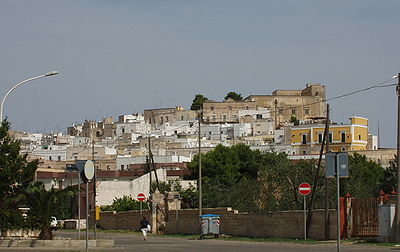CASTELLANETA
In the province of Taranto
where the geographic area is characterised by the presence
of ravines, is where Castellaneta is situated.
Its origins
date back to the Bronze Age (3.500-1.200 BC), as shown by
finds of vases and axes in the Minerva area. These settlements
were probably first realised by the Siculi and then the Lapigi.
The 5th Century BC, saw the beginning of the Hellenistic period
in all Messapian centres, guided by the powerful Taranto.
In 272 BC, Taranto was conquered by the Romans, who in this
way, subdued the whole of Puglia.
The City of Minerva was therefore integrated in the important
arterial commercial track called Via Appia (Appian Way). This
fact guaranteed the City’s prosperity for the entire
Imperial period.
The end of the Roman Empire coincided with the besiegement
and destruction of Minerva by the Visigoths of Alarica (411
AD) and the subsequent dispersion of the its population over
the whole territory.
After the Ostrogoth Empire period in Italy (476-535) and the
Greek-Gothic war fought against the Goths of the Byzantine
General Belisario (535-553), the City was refounded in 550
and renamed Castanea.
Successive Barbaric invasions during the 9th Century along
the territorial coasts of Puglia, determined escape by coastal
inhabitants towards the interior and the unification and enlargement
of the centre of Castanea, which took the name of Castellum
Unitum, and subsequently modified to Castellanetum.
After being at the centre of clashes between the Longobards
and the Byzantines for more than four centuries, Castellaneta
was taken by the Normans in 1064 and became an Episcopal seat
in 1080.
With the advent of the Swabians, the City was entrusted to
the patrimonial management of the diocese of Taranto.
The end of the Swabian Empire came about by the hand of Carlo
d’Angio (1266) and the City became a Royal City.
Next came the Aragonese (1442), who defeated and expelled
the Angioini from Southern Italy.
It then became Spanish property and rejected siege by French
troops commanded by Duke Nemours in 1503; known by historians
as the Sack of Castellaneta.
The City’s resistance merited the title of Fidelissima
Civitas given to it by King Ferdinand of Aragona.
When Charles Vth, Ferdinand’s nephew, ascended to the
throne in 1516, Castellaneta was given to the Flemish Guglielmo
de la Crou, but the citizens, adverse to the cessation, fled,
leaving the City to fall into ruin.
This saw the beginning of the domination of small feudatories
which continued until 1778.
The year 1799 saw the entry of French troops, led by Napoleon,
into the Italy, who diffused Republican values which led to
the beginning of the Republic of Naples (1808-1815), under
the guide of Gioacchino Murat. Castellaneta was not immune
to this epochal change, so much so, that the subsequent restoration
of the Bourbon regime was immediately opposed beginning in
1821 with the Carboneria (Association which promoted independent
ideas) of Castellaneta.
In 1860, Castellaneta entered into the new Reign of Italy
by means of a plebiscitary ballot.
In 1943, Castellaneta was bombed and heavily damaged during
clashes between the alliance troops and the Nazis during the
Second World War.
Castellaneta, with conserves an intact appearance of an 18th
Century City, with a Medieval town-planning, offers interesting
cultural stops to visit, beginning with: the Cathedral (1220)
which was later reconstructed in ‘700, with its Baroque
façade and precious paintings in its interior. Other
churches to visit: S. Frances (1471), San Domenic and San
Michael.
Among the feudatory buildings that governed the City, Palazzo
Sarapo and Palazzo Catalono, are worth mentioning.
Visits to the Gravina Grande are also interesting. Here the
inhabitants were guests during the centuries of Barbaric and
Saracen invasions. One can also enjoy the numerous Rupestrian
settlements here.
|
